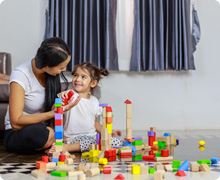Child-Directed Play
You can download this article as a PDF (English, Spanish).
 Child directed play (CDP) is a special form of one-to-one play between you and your child in which your child directs and leads. CDP can be used with children who are between about 2 and 10 with slight adjustments for age or developmental level. Research shows that playing with your child in this way can:
Child directed play (CDP) is a special form of one-to-one play between you and your child in which your child directs and leads. CDP can be used with children who are between about 2 and 10 with slight adjustments for age or developmental level. Research shows that playing with your child in this way can:
- Build a sense of self-direction and self-confidence in your child
- Foster child language and social development
- Allow your child to receive focused attention from you without having to misbehave to get it
- Strengthen your parent-child bond
- Help you practice parenting skills
How to do CDP
Look for a good time to join your child in play. Watch him or her. Get down on the floor together and within reason move where your child moves.
- Describe your child’s play, much like a radio sports announcer describes an exciting game. For example, you might say, “There goes the car over the bridge.” You don’t have to describe every detail, and will want to focus your attention on appropriate child behaviors.
- Imitate your child’s play activities. For example, if your child were building a tower with blocks, you might say, “Great idea. I’m going to build a tower too!”
- Repeat, with more detail, what your child has just said. For instance, if your child says, “There’s the bus,” you could say, “Yes, there goes the long, yellow bus up the hill.” This is a good way to help a young child learn more words without direct teaching. Do your best to repeat without turning what you say into a question.
- Give your child praise during play, identifying specific behaviors that you want to encourage. For example, you might say, “You’re really being careful with those blocks,” rather than, “Good job.” Try to comment on what your child does and how it’s done: “I see you’re stacking those blocks very carefully.”
- Allow your child to play with toys in any way that is not harmful. Keep in mind, there is no one right way to play with a toy.
Things to Avoid
- Giving commands about play or toys, such as, “Don’t get out the blocks yet.”
- Directing your child’s play. Stop yourself from giving the child your play ideas, and allow him or her to lead.
- Quizzing your child (e.g., “What color is that?” “Can you find a blue car?”).
- Asking questions. “Don’t you want to build a tower?” This can be a subtle way of taking control, or teaching.
- Using this time for competitive games. These can get into winning and losing, following rules, and power struggles.
Tips for Success
- Try this type of play with your child several times a week for no more than 10 to 15 minutes each time. Pick a time that fits your child’s mood and doesn’t compete with other activities.
- Pick a quiet place with no TV, other children or other distractions.
- Explain that this is your child’s “special time when I will play only with you.”
- Let your child know how long you will be playing together and give a warning when only a minute or two is left. It sometimes helps to set a timer, so that your child will know when the time will end.
- If the play becomes aggressive or unsafe, stop CDP. You can say, “This isn’t safe so we are going to stop playing now. We will try again tomorrow.” Then be sure that you do try again the next day. Your child will learn from this experience.
- Ignore less serious problems (arguing, whining, or bossy play), by pausing your play and turning away. Begin again only when the unwanted behavior stops. The basic idea is to ignore minor misbehavior (as long as it is safe).
- Praise good behavior as soon as it resumes. The idea is: Catch your child being good!
- If you wait out or ignore negative behavior for two or three minutes and your child doesn’t stop, then you should stop CDP. Just try again the next day!
To Learn More
- Your child’s healthcare provider
